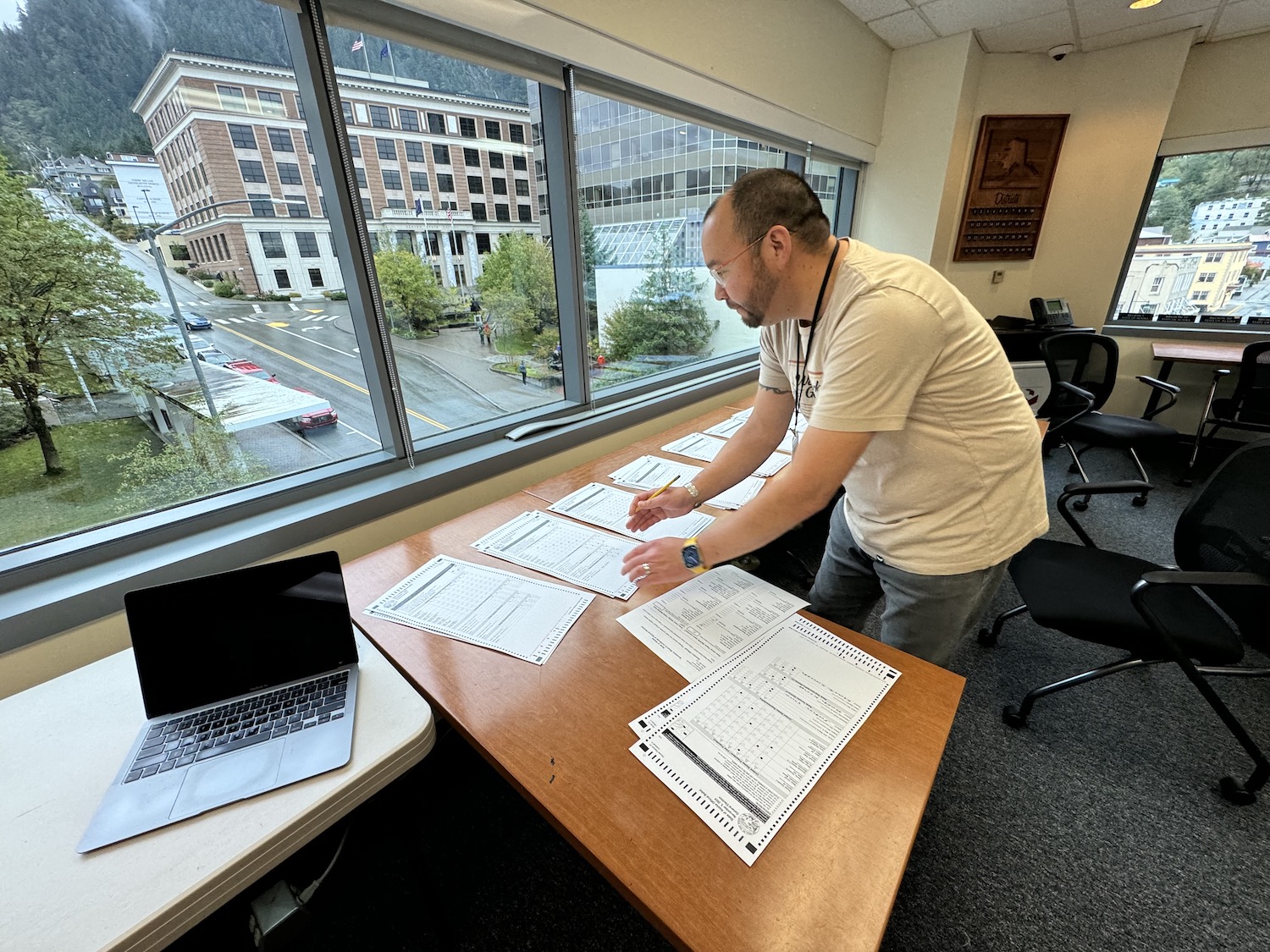
On Friday, officials in Georgia voted to require local elections officials to partially hand-count the results of the Nov. 5 general election.
Since 2020, when Republican presidential candidate Donald Trump falsely claimed that his loss was due to false counts from voting machines, some states and municipalities have begun counting ballots manually, instead of by machine.
The idea has occasionally come up in Alaska as well. In 2023, when state lawmakers considered a bill that would require the state to use open-source voting machines and software, testifiers urged lawmakers to eliminate machines altogether. Thus far, the idea hasn’t received serious consideration.
If Alaska were to mandate a hand count, it likely would result in slower election results but could be cheaper, according to an informal experiment conducted by the Alaska Division of Elections and the experience of the Matanuska-Susitna Borough, which hand-counts local elections.
In response to a question from the Alaska Beacon, state elections program manager Brian Jackson printed 51 sample 2024 election ballots and walked a reporter through a hand-sorting process for the presidential election.
More than a quarter of Alaska’s 402 voting precincts already use hand counts to tally first-choice Election Day results. Those precincts are generally in rural locations with low turnout.
Urban precincts use optical-scan machines that tally Election Day results quickly. The division randomly selects some precincts for a hand-count double-check.
This year’s presidential vote includes eight candidates. Sorting and counting the 51 first-choice votes for each of those eight candidates — plus blank ballots, overvoted ones and those with stray pen marks — took about 13 minutes.
In 2020, the last presidential election, Anchorage precincts generally saw at least 500 voters, with some seeing 1,000 or more.
A thousand-ballot precinct could take more than 200 person-hours to count, based on the experiment.
In addition, this informal experiment examined only one race, and there will be many on this year’s ballot — state House, state Senate, U.S. House, president, plus judicial retention votes and two ballot measures.
Multiply Jackson’s experiment by 21 — the number of races in some parts of the state — then multiply it again by turnout, and the result is a long time counting.
Election Day results are typically available in the early hours of the following day, but hand-counting might mean they’re unavailable for a day or more.
Jackson said it’s also important to think of the people involved. Right now, state hand counts are conducted by the people who also ran the polls on Election Day. The state would need to let those people sleep and eat, he noted.
In 2022, the Matanuska-Susitna Borough banned the use of voting machines for borough elections. Last year was its first hand-count election, and the borough clerk’s office delivered final results in 14 days, on par with its performance each year since 2019, when the borough started holding its local elections in November.
Election night results came surprisingly quickly, said Borough Clerk Lonnie McKechnie. With no state election to drive turnout and only a handful of races on the ballot, the first hand-count results came within a few hours, she said.
The Mat-Su gets around the issue of worker exhaustion by hiring two groups of workers — one for when the polls are open, and the second to count the ballots once the polls close.
Speaking Friday by phone, she said that this year’s election includes more races and coincides with the presidential election, which will drive up turnout. It remains to be seen how that experience will affect the hand count.
When it comes to cost, she said she thinks there’s “a little bit” of savings when compared to a machine count, but she didn’t have figures immediately at hand.
The Mat-Su’s experience doesn’t map perfectly to what the state of Alaska would have to do. Many of the state’s precincts are off the road system, and the Mat-Su doesn’t use ranked choice voting.
State laws and regulations pertaining to election procedures would likely have to change to accommodate a regular hand count.
In addition, the state hasn’t drafted an organized procedure for conducting a full ranked choice election by hand, something that Jackson said that would require the state to comingle absentee, questioned, early and Election Day ballots.
Currently, those ballots are kept separate to maintain an unbroken chain of custody and identify problems more easily.
Even without ranked choice voting, the state has limited recent experience with hand counts, and that experience tends to confirm the effectiveness of machine counting.
Four years ago, then-Lt. Gov. Kevin Meyer ordered a hand-count audit of all votes cast for and against Ballot Measure 2, which installed ranked choice voting and an open primary.
After the election was certified, elections workers spent days reviewing 361,400 ballots cast in the election, and the hand count was just 24 votes different from the machine count, confirming both the accuracy of the machines and the passage of Ballot Measure 2.
A subsequent records request by the Associated Press found that the audit cost more than $55,000 and that the lieutenant governor’s office had actually received few emails questioning the original result.

إرسال تعليق